Acupuncture & TCM Articles
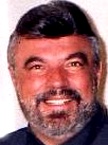
Acupuncture Articles
by John A. Amaro L.Ac., Dipl.Ac.(NCCAOM), DC
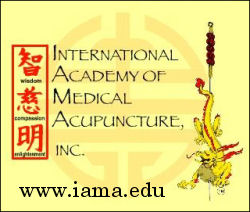 Dr. Amaro is an internationally known author, lecturer and practitioner beginning his practice of Acupuncture and Chiropractic in 1971. He has led 13 diplomatic Acupuncture study tours of The People's Republic of China escorting more than 500 doctors and practitioners. He has personally studied Acupuncture in nine separate Asian nations. Dr. Amaro is an internationally known author, lecturer and practitioner beginning his practice of Acupuncture and Chiropractic in 1971. He has led 13 diplomatic Acupuncture study tours of The People's Republic of China escorting more than 500 doctors and practitioners. He has personally studied Acupuncture in nine separate Asian nations.
He has received Certification in Acupuncture through the Columbia Institute of Chiropractic in 1973. This was one of the first Acupuncture postgraduate education programs for physicians in North America commencing in 1972.
He has been certified by the Waseda Acupuncture College in Tokyo, Japan in 1974 and graduated from the Chinese Medical Institute, Kowloon, China in 1976. He had previously taken postgraduate studies at the Tai Chung Medical School Taipei, China 1973.
The Chakras and the Flying Seven
John A. Amaro L.Ac., Dipl.Ac.(NCCAOM), DC
In the Oct. 1, 1992 issue of Dynamic Chiropractic, my friend, colleague, and fellow columnist Keith Innes, D.C., wrote a brilliant and provocative article concerning the adjusting procedure which he referred to as the flying seven. Everyone reading this column should, without question, read Dr. Innes' article.
Dr. Innes describes the flying seven as:
1. Some type of nonspecific general P to A thoracic adjustment, with no thought as to the location or direction of the spinal subluxation.
2 & 3. Right and left combination or straight arm adjustments to the upper thoracic spine.
4 & 5. Either a right and left SI adjustment or lumbar adjustment or combination thereof.
6 & 7. Supine rotary cervicals with no attempt made to screen for vertebral basilar insufficiency.
Dr. Innes then poses the question, "When and where did this insanity start?"
I found this article so interesting I felt compelled to hitchhike on Dr. Innes' topic.
The Sevenfold Journey: Chakras
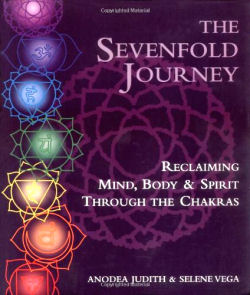 
Dr. Innes explained in his article that a group of chiropractic students conducted a research project on clinical practice by field practitioners. They selected the "elite" doctors of chiropractic in the area and watched and recorded their treatments. Their collective observations led to the discovery of the typical treatment being delivered; thus the name the flying seven was born.
I agree wholly with Dr. Innes when he states, "If chiropractic is just a few pushes here and there ... followed by the flying seven, then why did we all waste four years going to school? ... Let go of old doctrines and techniques with obsolete ... rationales, and welcome to 1993."
This brings me to one major problem. As the article pointed out, the students selected the "elite" of the chiropractic profession and everyone observed and conducted the flying seven routinely.
Of the thousands of DCs I have personally met through my career, there have only been a handful of practitioners who didn't use the flying seven as the basis of treatment. Therefore, one can only assume that since chiropractic care has stood the test of time for 98 years, with perhaps millions of patients receiving the flying seven adjustment, we can likewise assume that this adjustment has had certain if not a definite degree of success attached to it.
Even though Dr. Innes' article did not specifically say what I am about to say, I feel confident he would no doubt agree with me when I say the flying seven adjustment is nothing short of "back cracking" and "shotgun" therapy.
Granted, we are fast approaching the 21st century, and what we have learned to date about subluxation, fixation, and general chiropractic rationale is far different than what was being taught just a few years ago in chiropractic college. This is a whole new profession with entirely new insights, explanations and research findings. Or as Dr. Innes stated, "Chiropractic health care is a viable alternative, but it must be based on chiropractic diagnostic criteria of the 1990s which will lead to removal of all components of the spinal or extremity subluxation complex."
We still come back to the old question: Why through the course of our chiropractic history has the vast majority of millions and millions of adjustments been delivered with the flying seven? Even though this sequential adjustment procedure is very automatic for most practitioners in the profession, it is time we elevate ourselves to a higher degree of professionalism and rethink this flying seven business with regard to physically altering the biodynamics of the vertebral unit by a forceful, soft tissue altering manipulation.
My suggestion: Let's all become aware of static motor units and the dynamics of the spinal column in relation to the extremities and soft tissues. But when you are backed against the wall and patients are truly ill and not responding to traditional care, never, never forget the areas that were "shotgun adjusted" by the flying seven. Just use percussion, light tapping, laser, electrical stimulation or some other stimulation other than bone wrenching manipulation.
Remember, the same areas that are adjusted by the flying seven are routinely stimulated by "masters" in the area of acupuncture. No, these areas are not as young as the chiropractic profession by a long shot. In fact, the areas of focus of the flying seven are historically significant and owe themselves to the relationship of the seven chakras of the body and their relationship to the spine.
The problem of the flying seven is not in the area stimulated, it is the manner in which it is grossly manhandled. The areas which we stimulate traumatically by the flying seven adjustment are without question the most important areas of the spine for a variety of reasons.
Those of you who have studied acupuncture in North America or other non-Asian countries have most likely never related the chakra system of the body to acupuncture. It is the very rare book on acupuncture indeed that has even the remotest mention of this energetic system.
Most practitioners who hear the word "chakra" usually relate it to some "new age" thinking or have associated it with a mysterious Indian practice. However, the chakra system of the body is without question at the zenith of acupuncture therapeutics as practiced by Asians, especially at the "master" level of practice.
In brief, the chakras or "chi" consist of seven primary centers of energy and a host of secondary ones which are ultimately responsible for circulating the biomagnetic current over the meridian system of the body. If a meridian is affected or a vertebral segment, organ or system affected, the corresponding chakra is likewise affected and the reverse is also true.
The entire chakra system is under the ultimate control of the penetrating channel or "chang mo" of the extraordinary meridians which basically run through the middle of the body, from the head to the perineum. This is not to be confused with the conception vessel or "jen mo."
The chakras communicate to the front of the body: #1, the perineum (CV1); #2, just below the navel (CV6); #3, halfway between the xiphoid and navel (CV12); #4, just above the xiphoid (CV17); #5, at the manubrium (CV22); #6, between the eyebrows (yin tang); and #7 at the top of the head (GV20).
However, the chakras also communicate to the spinal levels: #1, the coccyx, sacrum and 5th lumbar; #2, the 4th lumbar; #3, T11 & T12; #4, T5 & T6; #5 C6 & C7; #6 C2; and #7 C1.
Anytime we take an action on the chakras, either from the anterior or posterior part of the body through percussion, or any other form of stimulation to include vertebral manipulation, we affect the entire meridian system of the body and especially the chakras of the related area.
I have had the good fortune to observe healers in most corners of the world and one thing which I have found to be consistent with the healers of the highest order is, believe it or not, stimulation of the spine by the flying seven.
Yes, Dr. Innes in his great article exposing the flying seven is correct that this adjustive procedure is not true chiropractic, orthopedic reduction of a static vertebral motor unit, and does not fit the model for proper subluxation correction based on diagnostic criteria. However, it has deep-reaching historical significance in assisting the body's bioenergetic balance in regaining health. This is probably exactly what we have been doing for 98 years to achieve the magnificent results we as a profession have obtained.
Remember, the same affect can be achieved with multiply struck Activator or a simple neurological hammer to the same areas in which we normally forcefully deliver a chiropractic adjustment in the flying seven.
In the accompanying illustrations of the spine and the Lovett-Brother relationship, I would like you to take a few minutes drawing a parallel between the spinal areas of the 1st chakra and the 7th chakra, namely from L5 to C1; the 2nd chakra and the 6th chakra from L4 to C2; the 3rd chakra and the 5th chakra from T11 & T12 to C6 & C7; and the 4th chakra at T5 & T6.
If you understand this concept, you will clearly recognize the rationale of stimulation of the general S1 and lumbar spine in relation to general stimulation of the lower and mid-thoracic spine, along with general stimulation of the atlas/axis and lower cervical spine.
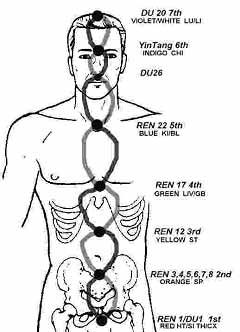 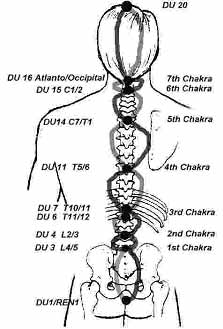
| 